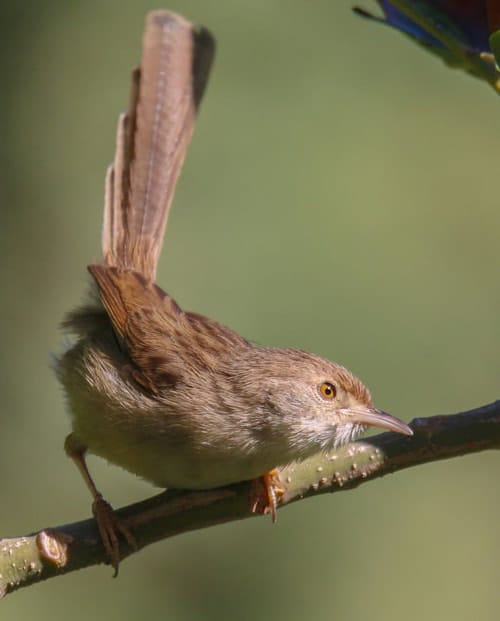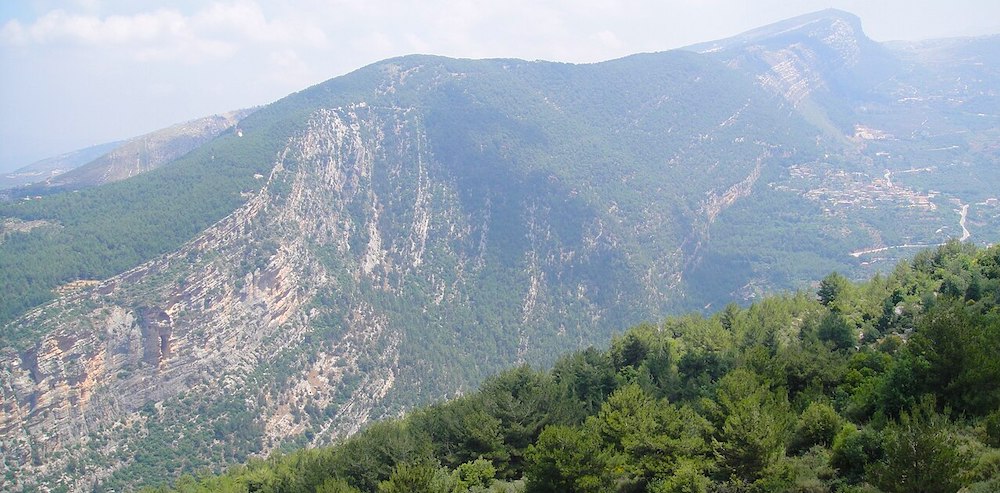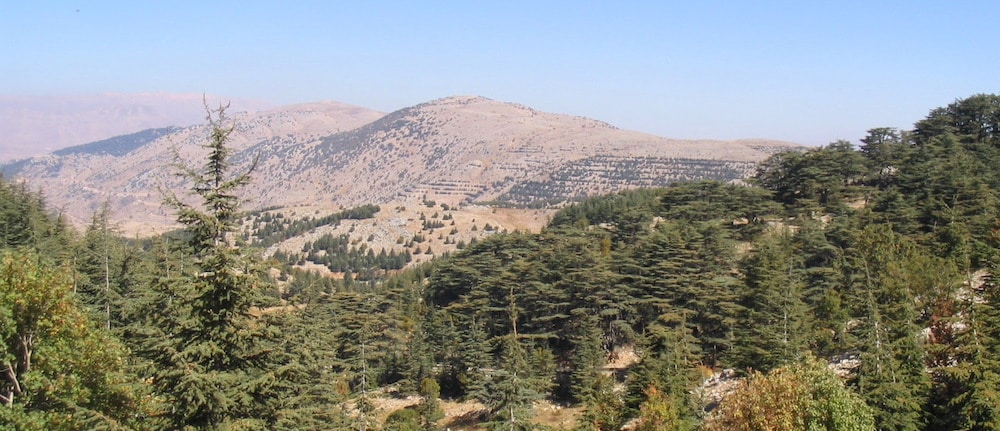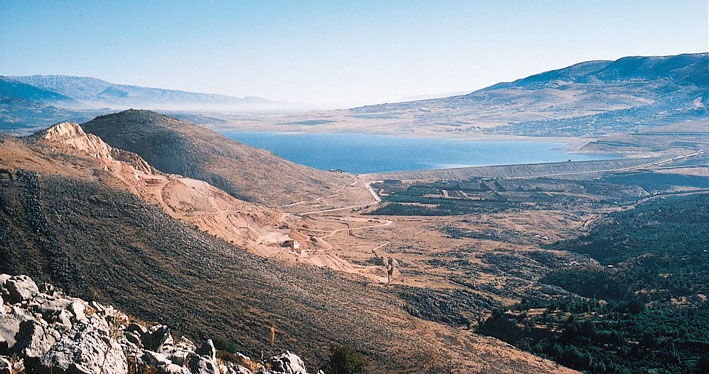Lebanese Republic

Lebanon is a country in the Levant region of the Middle East in West Asia. It is bordered by Syria to the north and east, by Israel to the south, and by the Mediterranean Sea to the west; Cyprus lies a short distance away from the country’s coastline. Lebanon is located at the crossroads of the Mediterranean Basin and the Arabian hinterlands. Lebanon has a population of more than five and a quarter million people and covers an area of just under 10,500 km2 (4,036 square miles). Beirut is the country’s capital and largest city where almost half of the country’s people live (2.4 million).The country has something of a mixed reputation. During the 1960s it was a fashionable destination for film stars, royalty and the jet-set. The intervening period saw several protracted civil wars and invasions. These days (mid 2024) it is considered a failed state with banking collapse, widescale poverty and political instability. Whether the main birding areas are accessible is not certain. UK Foreign Office advice should be sought before travel.
Lebanon is divided into four distinct physiographic regions: the coastal plain, the Lebanon mountain range, the Beqaa Valley and the Anti-Lebanon Mountains. The narrow and discontinuous coastal plain stretches from the Syrian border in the north where it widens to form the Akkar plain to Ras al-Naqoura at the border with Israel in the south. The fertile coastal plain is formed of marine sediments and river deposited alluvium alternating with sandy bays and rocky beaches. Lebanon’s mountains rise steeply parallel to the Mediterranean coast and form a ridge of limestone and sandstone that runs for most of the country’s length.

Mount Lebanon – ©Linaduliban Public domain, via Wikimedia Commons
The mountain range varies in width between 10 km (6 miles) and 56 km (35 miles); it is carved by narrow and deep gorges. They peak at over 10,000 feet above sea level in Qurnat as Sawda’ in North Lebanon and gradually slope to the south before rising again to a height of over 8,800 feet in Mount Sannine. The Beqaa valley sits between the Lebanon mountains in the west and the Anti-Lebanon range in the east; it is a part of the Great Rift Valley system. The valley is 180 km long and 10 to 26 km wide, its fertile soil is formed by alluvial deposits. The Anti-Lebanon range runs parallel to the Lebanon mountains, its highest peak is in Mount Hermon at over 9,200 feet). The mountains are drained by seasonal torrents and rivers foremost of which is the 145 kilometres (90 mile) long Leontes that rises in the Beqaa Valley to the west of Baalbek and empties into the Mediterranean Sea north of Tyre. Lebanon has 16 rivers all of which are non-navigable; 13 rivers originate from Mount Lebanon and run through the steep gorges and into the Mediterranean Sea, the other three arise in the Beqaa Valley.
Lebanon has a moderate Mediterranean climate. In coastal areas, winters are generally cool and rainy whilst summers are hot and humid. In more elevated areas, temperatures usually drop below freezing during the winter with heavy snow cover that remains until early summer on the higher mountaintops. Although most of Lebanon receives a relatively large amount of rainfall, when measured annually in comparison to its arid surroundings, certain areas in north-eastern Lebanon receives only little because of the rain shadow created by the high peaks of the western mountain range.

Al Shouf Cedar Nature Reserve – ©Yhabbouche Public domain, via Wikimedia Commons
In ancient times, Lebanon was covered by large forests of cedar trees, the national emblem of the country. Millennia of deforestation have altered the hydrology in Mount Lebanon and changed the regional climate adversely; now only around 13% is forested constantly threatened by wildfires. However, there is an active program to conserve and regenerate the forests. The Lebanese state has created several nature reserves that contain cedars, including the Shouf Biosphere Reserve, the Jaj Cedar Reserve, the Tannourine Reserve, the Ammouaa and Karm Shbat Reserves in the Akkar district, and the Forest of the Cedars of God near Bsharri. Since 2011, over 600,000 trees, including cedars and other native species, have been planted throughout the country as part of the Lebanon Reforestation Initiative, part of a ten year plan to increase forest cover to 20%.
Lebanon has the highest proportion of cultivable land in the Arab world. Major crops include apples, peaches, oranges, and lemons and agriculture employs up to a quarter of the people. A significant portion of the country’s factories, approximately one-third, is dedicated to producing packaged food items, ranging from poultry to pickles. However, despite favourable conditions for farming and diverse microclimates, the country depends on food imports, constituting 80% of its consumption.
Birding Lebanon
Most of Lebanon is mountainous terrain. There is a narrow coastal strip in the west of the country, the Mt Lebanon range forms the backbone of Lebanon range running roughly north – south through the centre of the country. The moderately high – altitude Beqaa valley in-between the Mt Lebanon range from the Anti-Lebanon range and Mt Hermon which form the country’s eastern border.
The diversity of habitats and the fact that Lebanon lies on the Eastern Mediterranean Flyway means that even for its small size Lebanon has a very diverse avifauna. European and Middle-Eastern Species are represented and the country’s position is possibly why so many vagrant species have been recorded. The migration seasons are truly spectacular, on a good day 1000s of raptors, storks and other soaring birds can be observed along the flyways and at bottlenecks. There are also considerable passages of passerines along the coast and through the Beqaa Valley.

Beqaa Valley – ©fouad awada Public domain, via Wikimedia Commons
In total to date, 406 taxa have been recorded, with a number of new species added to the country list since the last official checklist was published in 2008. At least 20 biome restricted species of Mediterranean, Irano-Turanian or Saharo-Sindian desert origins are fairly common to very common and breed in Lebanon at various locations. Lebanon is one of the only countries in the Middle East to have breeding populations of Blue-Tit and specialities include the Chukar, an endemic sub-species of White-throated Dipper and the globally Vulnerable Syrian Serin.
In good times, on top of the birds Lebanon offers great hospitality and has excellent food and wine. The food is food is world famous and among the wines Chateau Musar is considered one of the world’s greatest. The country is also famous for the Cedars of Lebanon, several groves remain, including some trees which are estimated to be at least 2000 years old. There are also several historical and world heritage sites such as: The temple of Bacchus at Baalbek, one of the world’s best preserved and grandest Roman Temples; Byblos which has been continually inhabited since at least 5,000BC; Beaufort Castle which has been used in every war since it was built during the crusades; and Anjar which holds some of the world’s best-preserved Umayyad Caliphate ruins.
-
Aammiq Marshes Lebanon
InformationSatellite ViewThe Aammiq Marshes lie in the Beka'a Valley in the centre of the country to the east of the capital, Beirut. This swamp is the largest and most important wetland area between Turkey and Israel and despite hunting and habitat loss remains the most important site for wetland birds in Lebanon. Early in the year the marshes can flood to nearly 300ha with meltwater from the mountains but by autumn they may be completely dry. Conservation programmes carried out in the marshes in recent years have involved returning some of the land loss to agriculture back into marshland. Surrounding the wetland are areas of rough grazing, cultivated land, drainage ditches, and an avenue of trees, all adding to the diversity of habitats in the area. On the nearby mountain slopes, small wooded areas and rocky shrubland give an even greater variety of habitats and species. Behind the nearby village of Aammiq is a woodland where Scops Owl and Syrian Woodpecker can be found. In spring and summer, shrubby hillsides are home to Great Spotted Cuckoo, various buntings, wheatears, warblers and shrikes, and rocky gorges host Rock Nuthatch and perhaps still Eagle Owl… -
Palm Islands Natural Preserve
InformationSatellite ViewThe Palm islands park is a unique and integrated natural marine basin in the eastern Mediterranean that was declared as a reserve in 1993. Its surface area is about 5 Km2. This maritime park lies 11 kms north-west off the shores of el-Mina in Tripoli. These flat rocky islands include the Palm (or Rabbit) island, Sanani island, and Ramkine (or Fanar) island. The islands are chosen as nesting sites by 10 species of migrant birds, including: Little Ringed Plover, Common Tern, Sand Martin, Little Crested Tern, Little Tern, Whiskered Tern, Black-Winged Stilt, etc. The islands has 24 recorded species of winter-visiting fowl, including: Manx & Cory`s Shearwater, Peregrine, Little Stint, Redshank, Marsh Hawk, White-Tailed Eagle, etc.. Visitors include: Ruff, Snowy plover, White-Winged Black Tern, Sandwich Tern, Black Tern, Osprey, Ruddy Turnstone, Sociable Plover, Sanderling, Gull-Billed Tern, Pied Avocet, etc..
-
Number of bird species: 406
(As at July 2024)National Bird: Asian Crimson-winged Finch Rhodopechys sanguineus
-
Avibase
PDF ChecklistThis checklist includes all bird species found in Lebanon , based on the best information available at this time. It is based on a wide variety of sources that I collated over many years. I am pleased to offer these checklists as a service to birdwatchers. If you find any error, please do not hesitate to report them. -
SPNL
ChecklistSince the previous published checklist of the birds of Lebanon in 2008, many significant changes to the status and distribution of birds have been recorded. Checklists evolve and the one presented here uses the standardised taxonomic list for the OSME region. Of the 404 species recorded in Lebanon, nine have been added since the 2008 list; 284 (70.3%) are passage migrants or winter visitors (or both); 69 (17.1%) are vagrants; 73 (17.8%) are summer breeders and 65 (16.1%) are breeding residents -
Wikipedia
Annotated ListThis list's taxonomic treatment (designation and sequence of orders, families and species) and nomenclature (common and scientific names) follow the conventions of The Clements Checklist of the Birds of the World, 2022 edition. -
Wild Lebanon
PDF Checklist -
eBord
PDF ChecklistThis checklist is generated with data from eBird (ebird.org), a global database of bird sightings from birders like you. If you enjoy this checklist, please consider contributing your sightings to eBird. It is 100% free to take part, and your observations will help support birders, researchers, and conservationists worldwide.
-
A Naturalist's Guide to the Birds of Egypt and the Middle East
| By Richard Hoath | John Beaufoy Publishing | 2022 | Paperback | 176 pages, colour photos, tables | ISBN: 9781913679026 Buy this book from NHBS.com -
Birds of Europe, North Africa, and the Middle East
| A Photographic Guide | By Frédéric Jiguet & Aurélien Audevard | Princeton University Press | 2017 | Paperback | 447 pages, 2200 colour photos, colour distribution maps | ISBN: 9780691172439 Buy this book from NHBS.com -
Birds of Lebanon, Syria and Jordan
| By Vere Benson | BirdLife International | 1970 | 218 Pages, 8 colour plates. B/w drawings, map. (In Arabic) | Out of Print | ISBN: 9780946888016 Buy this book from NHBS.com -
Birds of the Middle East
| By AbdulRahman Al-Sirhan, Jens Eriksen & Richard Porter | Helm | 2022 | Paperback | 224 pages, 400 colour photos | ISBN: 9781472986757 Buy this book from NHBS.com -
Birds of the Middle East
| By Richard Porter, Oscar Campbell, AbdulRahman Al-Sirhan, John Gale, Mike Langman, Brian E Small & Alan Harris | Helm | Edition 3 | 2024 | Paperback | 400 pages, 180 colour plates, 636 colour distribution maps | ISBN: 9781399401968 Buy this book from NHBS.com
-
ABCL The Association for Bird Conservation in Lebanon
WebsiteThe ABCL is a group of like-minded people whose aim is to prevent the illegal killing and capture of birds in Lebanon and promote bird conservation. -
BirdLife
WebsiteSo far, 134 species have been recorded breeding in Lebanon. Only 110 breed regularly, the rest being either occasional or former breeders. Of the 110 regular breeders, 56 are exclusively residents (i.e. their populations remain within Lebanon) such as Sparrow, Palm Dove, Yellow-legged Gull, Graceful Warbler, Bulbul, Chukar, Long-legged Buzzard. 54 are exclusively summer breeders (i.e. winter elsewhere but breed in Lebanon) such as Turtle Dove, Pallid Swift, Swallow, Red-backed Shrike, White Wagtail. -
Birds of Lebanon
Facebook PageIn this group we share pictures, and information about the birds exclusively in Lebanon -
OSME (Ornithological Society of the Middle East)
WebpageLebanon lies on one of the most important migration routes for birds, the Eastern Mediterranean Flyway. Thus a significant number and variety of birds pass through the country, or winter in it each year. Indeed, the wide diversity of habitats found in Lebanon makes it the perfect place to breed for different species. -
SPNL Society for the Protection of Nature in Lebanon
WebsiteSPNL strives to conserve biodiversity for the provision of a better quality of life through sustaining sites, habitats, species and people - Hima literally means “a protected place”. BirdLife International in the Middle East, led by the Society for the Protection of Nature in Lebanon (SPNL, BirdLife Partner), is now reviving hima in the region. The goal is to mesh these wise traditional practices with recent conservation science in order to achieve sustainable development…
-
BR Al Shouf Cedar Nature Reserve
InformationSatellite ViewNoura Jumblatt has been awarded the Forest for Kyoto Prize by the Italian Environment Ministry for her extensive ecological efforts in the Chouf. The prize, named after the Kyoto Protocol on climate change and improvement, entitles Jumblatt to select an area in Lebanon where the Italian government will plant a new forest… -
BR Jabal Al-Rihane
InformationSatellite ViewA true mosaic of ecological systems broadly representing the 'evergreen forests' bio-geographic region within a Mediterranean biome. The Rihane differs from other protected areas in Lebanon by its situation at middle altitudes. All the others are either at high altitude with dominance of cedar trees (Tannourine, Ehden, Al-Chouf Cedar reserves) or at very low altitudes such as Palm Islands or Tyre Beach reserves. Also it differs by its nature from the Aammiq wetland. -
BR Jabal Moussa
WebsiteSatellite ViewLocated in Keserwan-Jbeil area, Lebanon, surrounded by Nahr Ibrahim and Nahr Ed-Dahab rivers, and located 50 km away from the capital Beirut, Jabal Moussa was designated in 2009 as the third biosphere reserve in Lebanon as part of the UNESCO Network of Biosphere Reserves -
IBA Jabal Moussa
WebsiteSatellite ViewThe site is a mountain which extends westwards from the main Mount Lebanon chain along the edge of the Nahr Ibrahim, just to the west of Jabal Aalmat on the opposite side of the river. Total area: 6500ha. The site is known or thought to be a ‘bottleneck’ site where at least 20,000 storks (Ciconiidae) or raptors (Accipitriformes and Falconiformes) or cranes (Gruidae) regularly pass during spring or autumn migration. 14 large and medium mammal species such as the Rock Hyrax. 215 plant species among which 20 tree species and 11 endemics. -
IBA Ras Baalbek
WebpageSatellite ViewThe Ras Baalbek IBA is found at the extreme north end of the Bekaa Valley, in north-east Lebanon, extending up into the foothills of the Anti-Lebanon mountain range, in between the towns of Ras Baalbek and El Qaa. 10 biome-restricted species, mostly from the Saharo-Sindian Desert Biome breed here – Cream-coloured Courser, Bar-tailed Lark, Desert Lark, Temminck’s Lark, Mourning Wheatear, Streaked Scrub Warbler, Trumpeter Finch, Western Rock Nuthatch, Pale Rock Sparrow and Spectacled Warbler. Of these species, 7 are rare or unknown as breeders elsewhere in Lebanon. Several other species breed here commonly which are also scarce or rare breeders elsewhere in the country such as Little Owl and Greater Short-toed Lark. -
Lake Qaraoun
WebpageSatellite ViewLake Qaraoun is the largest freshwater body by far in Lebanon, lying at the Southern end of the Bekaa valley, which is a continuation of the Rift valley itself, a well – documented flyway for raptors and other soaring birds. Observations suggest that over 20,000 raptors, Storks, Pelicans and other soaring birds pass over the lake annually. Several species of conservation concern have been recorded here in past years such as Sociable Plover, and Ferruginous Duck. Also the most important site in Lebanon for wintering ducks. Number of species observed: 110. -
List of Wetlands of International Importance
WebpageSatellite ViewLebanon currently has 4 sites designated as Wetlands of International Importance (Ramsar Sites), with a surface area of 1,075 hectares. -
NR Bentael Forest
WebpageSatellite ViewA steep sided valley mostly covered with dense woodland (Oak, Pine), and Strawberry Tree with some steep cliffs and caves. There is an estimate annual autumn passage of soaring birds exceeding 3000, including White Pelican, Common Crane, European Honey-buzzard and Levant Sparrowhawk. Number of species observed: 62. ammals including Wild Boar, Persian Squirrel, Red Fox and Porcupine. -
NR Ehden Forest (Horsh Ehden)
WebpageSatellite Viewediterranean forest ecosystem, Cedars, firs, junipers, oak mixed with fire colored maples. The site contains the country’s last protected community of wild apple trees (Crabapple), and a multitude of rare and endemic plants. Situated between 1200-2000 m elevation on the upper northwestern slopes of Mount Lebanon. Total area: 140 ha. Most balanced Mediterranean forest ecosystem in Lebanon. A1 & A2 migration stop over site for a number of threatened bird species such as Imperial Eagle, Lesser Kestrel and Syrian Serin. -
NR Palm Islands - Tripoli
InformationSatellite ViewThe Palm islands park is a unique and integrated natural marine basin in the eastern Mediterranean that was declared as a reserve in 1993. Its surface area is about 5 Km2 (1.4 x 1.08 nautical miles). This maritime park lies 6 nautical miles (11 Km) north-west off the shores of el-Mina in Tripoli (Latitudes: 34d 29m - 34d 30m 30s N and Longtitudes 35d 44m 30s - 35d 47m E). These flat rocky islands include the Palm (or Rabbit) island, Sanani island, and Ramkine (or Fanar) island… -
PA Ebel Es-Saqi
WebpageSatellite ViewSouthern Lebanon between Marjayoun and Hasbaya, west of the Hasbani River. Village lies on the Rift valley flyway, well documented for migratory raptors and soaring birds. A1 presence of globally and regionally threatened soaring bird species in Lebanon such as Dalmatian Pelican, Greater Spotted Eagle, Egyptian Vulture, Pallid Harrier, Imperial Eagle, Lesser Kestrel, and Corncrake stresses the importance of this area on an international scale. A3 evidence of 5 biome restricted species breeding: Masked Shrike, Upcher’s Warbler, Sardinian Warbler, Cretzchmar’s Bunting and Black-headed Bunting. A4iv Very large numbers of migrating soaring birds in spring and autumn, including at least 17 species. 60,000 Common Crane witnessed on one day in February 2005 sufficient alone to ensure IBA status. Large numbers of European Honey-buzzard, White Stork, and White Pelican have been seen in autumn. Rock Hyrax, Wild Cat, Red Fox, Jackal, possible Otter, Wild Boar. -
PA Kfar Zabad Wetlands
WebpageSatellite ViewEastern Bekaa, at foot of the Anti-Lebanon mountain range, in the municipalities of Anjar and Kfar Zabad. Total area: 326 ha. At least fifteen breeding pairs of Syrian Serins (Serinus syriacus) were present at the site in spring 2005, plus Lebanon’s second only record of Bearded Tit. Number of species observed: 69. Common Otter (Lutra lutra), Wild Cat (Felis sylvestris), reptiles and amphibians. -
RCS Aammiq Wetland
InformationSatellite ViewThe Aammiq Wetland is the most significant remaining freshwater wetland in Lebanon, a remnant of much more extensive marshes and lakes that once existed in the Bekaa Valley. It has been designated an Important Bird Area in the Middle East (Birdlife International, 1994) and is included in the Directory of Wetlands in the Middle East (IUCN, 1995). The Aammiq Wetland lies on one of the most important bird migration routes in the world, and over 250 species of bird have been recorded in the area, including the globally vulnerable Great Spotted Eagle Aquila clanga, Imperial Eagle Aquila heliaca, and Lesser Kestrel Falco naumanni. Records of globally near-threatened bird species in the area include Great Snipe Gallinago media, Ferruginous Duck Aythya nyroca and Pallid Harrier Circus macrourus…
-
eBird
SightingseBirding This Month
-
Dave Lebanon DMC
GuideLebanon has a wide variety of habitats including the Mediterranean coastline and coastal plains leading up to the Mount Lebanon mountain range which runs north-south through the country. Further east lies the Beqaa Valley with areas of wetland in the center around Aammiq and Anjar. There is semi-desert in the north around Ras-Baalbek, and to the west of the Beqaa Valley are the anti-Lebanon mountains. -
Lebanon Birdwatching Tours
Tour OperatorWe organize birding tours and birdwatching holidays in Lebanon. Our birding tours are highly customized to your needs. -
OSME
Potential TripOSME are teaming up with Sunbird to develop a suitable itinerary for birders and potentially arrange an organised trip to the country next spring.
-
2018 [October] - Tomas Axén Haraldsson.
PDF ReportAll arranged through the Bird Camp project and local transports, restaurants, visits and permits arranged through SPNL and local partner MESD in Ras al-Matn village. -
2019 [04 April] - Tomas Axén Haraldsson
PDF ReportThis was a cooperation between Society for Protection of Nature in Lebanon (SPNL, the BirdLife partner in Lebanon), BirdLife Sweden and the Ornithological Society of the Middle East, Caucasus & Central Asia (OSME). This time we were also joined by one Turkish participant!
-
Hunting Laws in Lebanon
WebsiteFor over three years, hunting has been totally banned in Lebanon. The ban came after a prolonged struggle between the government on one side, and the hunters, gun shops (especially in Shtoura), and gunshot manufacturers on the other side. It finally took effect in January 1995. By August 1995, when I visited Lebanon, the difference was already noticeable in both the peaceful countryside and the chattering of large numbers of birds. -
Lebanon
WebsiteThis small eastern Mediterranean country has some rich birding, mainly in migration times, but this fact is often overshadowed by the continuing political instability and rampant illegal bird hunting.
-
Photographer - Fouad Itani
GalleryDue to its wide diversity of habitats and its position on a major world bird migration route, Lebanon offers some of the best birdwatching in the world.

